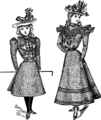




Coats, jackets, and trousers
By the 1890s, the sack coat (UK lounge coat) was fast replacing the frock coat for most informal and semi-formal occasions. Three-piece suits consisting of a sack coat with matching waistcoat (U.S. vest) and trousers were worn, as were matching coat and waistcoat with contrasting trousers.
Contrasting waistcoats were popular, and could be made with or without collars and lapels. The usual style was single-breasted.
The blazer, a navy blue or brightly-colored or striped flannel coat cut like a sack coat with patch pockets and brass buttons, was worn for sports, sailing, and other casual activities.
The Norfolk jacket remained fashionable for shooting and rugged outdoor pursuits. It was made of sturdy tweed or similar fabric and featured paired box pleats over the chest and back, with a fabric belt. Worn with matching breeches or (U.S. knickerbockers, it became the Norfolk suit, suitable for bicycling or golf with knee-length stockings and low shoes, or for hunting with sturdy boots or shoes with leather gaiters.
The cutaway morning coat was still worn for formal day occasions in Europe and major cities elsewhere.
The most formal evening dress remained a dark tail coat and trousers with a dark or light waistcoat. Evening wear was worn with a white bow tie and a shirt with a winged collar.
The less formal dinner jacket or tuxedo, which featured a shawl collar with silk or satin facings, now generally had a single button. Dinner jackets were appropriate formal wear when "dressing for dinner" at home or at a men's club. The dinner jacket was worn with a white shirt and a dark tie.
Knee-length topcoats, often with contrasting velvet or fur collars, and calf-length overcoats were worn in winter.
Source from : http://en.wikipedia.org/wiki




















































